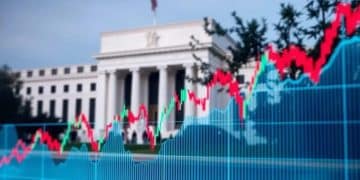Key updates from the Federal Reserve today and their impact

Key updates from the Federal Reserve today involve interest rate adjustments that impact borrowing costs and inflation, shaping economic growth and consumer spending.
Key updates from the Federal Reserve today can significantly affect the economic landscape. Are you curious how these changes might impact your daily life and finances? Let’s dive in.
Understanding the Federal Reserve’s role
The Federal Reserve plays a crucial role in the U.S. economy. It’s important to understand how its decisions affect everyone. The Fed manages monetary policy, which influences things like interest rates and inflation.
What does the Fed do?
The Federal Reserve has several key functions:
- Regulating and supervising banks.
- Conducting monetary policy.
- Maintaining financial stability.
Each of these roles helps ensure that the banking system operates efficiently. For example, when the Fed adjusts interest rates, it directly impacts how much consumers pay for loans.
How does monetary policy work?
Monetary policy is set through tools like open market operations, discount rates, and reserve requirements. These tools allow the Fed to control the money supply:
- Open market operations: Buying or selling government bonds.
- Discount rate: The interest rate charged to commercial banks.
- Reserve requirements: The amount of funds banks must hold in reserve.
By managing these tools, the Federal Reserve can influence economic activity. For instance, lowering interest rates can stimulate spending and investment.
In addition to these functions, the Fed is also responsible for keeping the economy stable during crises. It serves as a lender of last resort, providing liquidity to banks during tough times. Understanding the Fed’s role is essential to grasp how economic policies impact daily life.
Recent decisions made by the Federal Reserve
Recent decisions made by the Federal Reserve have significant implications for the economy and individuals alike. These choices can influence borrowing costs and overall economic growth. Understanding these actions is essential for anyone wanting to stay informed.
Interest Rate Adjustments
One of the most impactful decisions made by the Fed involves adjusting interest rates. Recently, the Fed increased rates to combat rising inflation. When rates go up, loans become more expensive, affecting everything from mortgages to car purchases.
- Rising costs for consumers: Higher interest rates mean that consumers pay more for loans.
- Impact on savings: Interest rates on savings accounts may also rise, allowing people to earn more.
- Effect on investments: Stock markets may react negatively to rate hikes as borrowing costs for companies increase.
Higher rates are typically seen as a tool to keep inflation in check, but they can slow economic growth in the process.
Bonds and Asset Purchases
The Fed also makes decisions regarding bonds and other asset purchases. Recently, the Fed has started tapering its bond-buying program, which helps signal a shift in monetary policy. This can lead to changes in liquidity in the market. When they reduce these purchases, it often aims to tighten monetary policy to curb inflationary pressures.
- Reducing liquidity: Decreasing bond purchases leads to less money circulating in the economy.
- Market adjustments: As the Fed pulls back, markets may face initial volatility as investors adjust to new conditions.
- Long-term strategies: The Fed’s approach can change based on economic indicators and forecasts.
These recent actions reflect the Fed’s commitment to controlling inflation and stabilizing economic growth. As they navigate these changes, it is crucial to monitor how these decisions affect various aspects of personal finance.
How interest rate changes affect consumers

When the Federal Reserve changes interest rates, it has a direct impact on consumers’ lives. These adjustments can influence how much you pay for loans and how much you save. Understanding these effects is essential for managing personal finances.
Borrowing Costs
One immediate effect of rising interest rates is the increase in borrowing costs. When interest rates go up, individuals who want to secure loans for homes or cars face higher monthly payments. This can lead to:
- More expensive mortgages: Home buyers will likely find higher rates, resulting in increased monthly payments.
- Costlier auto loans: Car buyers will also pay more in interest, affecting their budgets.
- Higher credit card rates: Existing credit card debt becomes more expensive to manage.
As rates rise, many consumers may delay major purchases or reconsider their budgets.
Savings and Investments
On the other hand, consumers with savings accounts might benefit from higher interest rates. Financial institutions often raise savings rates in response. This can result in:
- Increased savings returns: Consumers earn more on their deposits.
- Better investment opportunities: Higher rates can lead to more attractive returns on bonds and fixed-income investments.
While higher interest on savings accounts can be a positive change, it can also signal a slowing economy. It’s vital to balance the benefits of higher savings returns with the costs of borrowing. Additionally, fluctuations in interest rates can impact stock market performance, which may affect investment portfolios.
Awareness of how interest rate changes affect consumers allows for better financial planning. Making informed decisions can help navigate these economic shifts.
The impact of monetary policy on the economy
The impact of monetary policy on the economy is profound and wide-ranging. Decisions made by the Federal Reserve influence borrowing, spending, and overall economic growth. Understanding this connection helps individuals navigate financial landscapes.
Influence on Inflation
Monetary policy directly affects inflation rates. When the Fed adopts a expansionary policy, it typically lowers interest rates. This encourages borrowing and spending, which can drive prices higher. Conversely, a contractionary policy, which raises interest rates, aims to cool off inflation by reducing spending.
- Lower interest rates: Encourage more consumer spending and business investments.
- Higher interest rates: Deter spending and can stabilize prices.
- Inflation targeting: The Fed often aims for a specific inflation rate to maintain economic stability.
This balancing act is crucial for sustained economic health.
Employment and Economic Growth
Changes in monetary policy also influence employment levels. Lower interest rates can lead to job creation as businesses invest in expansion. When companies can borrow easily, they are more likely to hire. However, higher rates could slow growth. This can lead to:
- Stagnation: Slower job growth due to higher borrowing costs.
- Job losses: Companies may cut back on hiring or reduce staff during economic downturns.
- Stability: A balanced approach can help maintain steady employment levels.
Ultimately, the effectiveness of monetary policy is often reflected in overall economic performance. When the Federal Reserve implements changes, the ripple effects can be felt across various sectors. By maintaining awareness of these impacts, individuals and businesses can make informed decisions in response to shifting economic conditions.
Future outlook for the Federal Reserve’s actions
The future outlook for the Federal Reserve’s actions is closely watched by economists and consumers alike. As the economy fluctuates, the Fed will adjust its policies to promote stability and growth. Recent trends indicate that the Fed may be facing some challenges ahead.
Inflation Concerns
With inflation rates rising, the Fed will likely need to continue its tightening measures. This means higher interest rates could be on the horizon, as the Fed aims to control inflation by discouraging excessive spending and borrowing. These measures can lead to:
- Higher borrowing costs: Consumers will feel the pinch on loans, which may slow down major purchases.
- Increased savings rates: Higher interest on savings accounts might encourage people to save more.
- Market volatility: Financial markets often react to rate hike announcements, leading to potential instability in investments.
The focus will remain on balancing inflation with economic growth.
Unemployment Rates
Another critical area affecting the Fed’s decisions is the unemployment rate. As job growth continues, the Fed may need to take a closer look at employment trends. When employment is strong, the Fed may be more inclined to raise rates to combat inflation. On the other hand, if job growth slows down, they could consider:
- Maintaining or lowering rates: This would provide support for businesses and consumers.
- Encouraging investment: Lower rates could spur spending and hiring.
- Monitoring economic indicators: The Fed will continue to analyze various metrics to guide their decisions.
The interplay between inflation and unemployment will play a significant role in shaping future monetary policy.
In summary, the journey ahead for the Federal Reserve involves navigating through economic uncertainties. Adaptability and responsiveness to changing conditions will define how the Fed acts in the coming months and years. Keeping an eye on these trends will be essential for consumers and businesses alike.
In conclusion, understanding the Federal Reserve’s actions is vital for everyone. Changes in interest rates and monetary policy shape our daily lives and financial decisions. As we move forward, keeping an eye on inflation and employment rates will be crucial. The future outlook will depend on how the Fed navigates these challenges, impacting consumers and businesses alike. Being informed helps us make better financial choices and adapt to economic changes.
FAQ – Frequently Asked Questions about Federal Reserve Actions
What is the main role of the Federal Reserve?
The Federal Reserve manages the U.S. monetary policy, regulating interest rates and controlling inflation to ensure economic stability.
How do interest rate changes affect consumers?
Interest rate changes can influence borrowing costs, making loans more or less expensive, which affects major purchases and savings.
What is the connection between monetary policy and inflation?
Monetary policy aims to control inflation by managing the money supply; for instance, lowering rates can stimulate spending, raising rates can slow inflation.
How does the Federal Reserve influence employment rates?
The Fed’s policies, particularly regarding interest rates, can stimulate or cool job growth, affecting overall employment levels in the economy.





